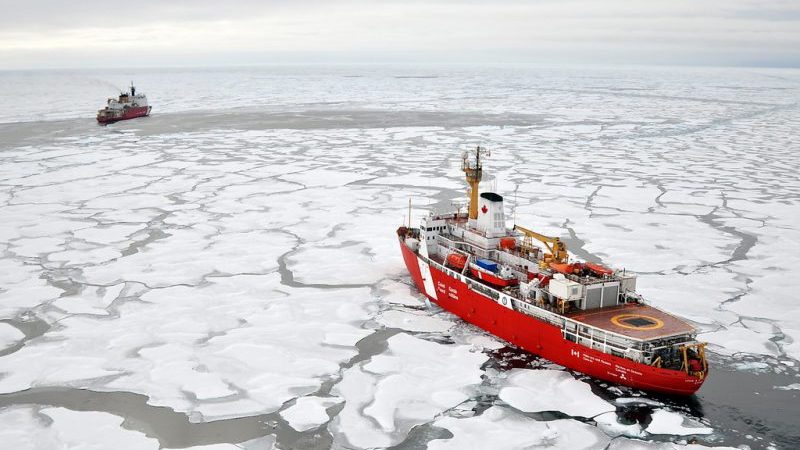Arctic countries and indigenous communities are calling for a ban on ships burning heavy fuel oil (HFO) in the region, extending a measure already imposed in Antarctica.
Advocates for the ban warn the risk of heavy fuel oil spills is increasing as melting sea ice, linked to climate change, is opening the sensitive environment to seaborne trade.
The International Maritime Organization (IMO) is discussing the issue this week, with a view to giving instructions to a technical committee that will begin work in early 2019.
“HFO represents the cheapest fuel that the global shipping industry could use if the Arctic were ice-free,” Austin Ahmasuk, an Alaskan from the Bering Straits nonprofit group Kawerak, Inc, said on the sidelines of the IMO meeting on Monday. “The natural logical concern is that shipping is going to increase, there’s going to be an increase in HFO presence in the Arctic, and that represents a potential significant risk.”
The Bering Sea lost around half of its sea ice cover in two weeks in February, accentuating concerns about increased shipping in waters that used to be frozen, according to the Clean Arctic Alliance. Three-quarters of Arctic summer sea ice has melted since the 1970s and the remainder is expected to disappear before 2050, it added.
In Alaska, February sea ice levels were at their lowest in living memory, said Verner Wilson, an Alaskan working with Friends of the Earth International.
“February and March is when we have the most sea ice,” he said. “It really hurts [communities’] ability to go hunting for marine wildlife that we have depended on for thousands of years. We depend on that sea ice not just to protect the communities from erosion, but also to continue our traditional ways of life.”
Timelapse video: shipping first as LNG tanker crosses Arctic in winter
Heavy fuel oil accounts for around 80% of marine fuel used worldwide and 75% of the fuel carried in the Arctic, the campaigning network said. More than half the ships crossing the Arctic seas are flagged in non-Arctic countries.
HFO emits more air pollutants such as sulphur oxide and black carbon than alternatives like distillate fuel and liquefied natural gas. Black carbon acts as a global warming agent and when it settles on ice, it can make it reflect less sunlight and melt more quickly.
Green groups started pushing for a ban in the Arctic around the time the IMO negotiated the “Polar Code” to exclude the heavy fuel oil from Antarctica, which was adopted in 2014. A group of seven countries, led by the US and Canada, put it on the organization’s agenda last July.
Most Arctic countries are supporting the ban, including Norway, Sweden, Finland and Iceland, along with the Netherlands, Germany and New Zealand. Finland has proposed imposing it by 2021.
But there are potential spoilers too. Russia, one of the biggest shipping players in the Arctic, has not expressed support for the ban, and other big shipping countries outside the region appear resistant any move to close off the emerging route.
In a more unexpected shift, Canada and the Marshall Islands responded to Finland’s proposal last month by cautioning not to set a ban too quickly. They argued the IMO must first evaluate the economic effects of higher shipping costs on northern indigenous communities that depend on shipped goods, Radio Canada International reported.
Both Canada and the Marshall Islands, the world’s second-largest shipping registry, are vocal advocates for setting a strong greenhouse gas emissions reduction strategy in the global maritime industry.
Investigation: The tax-free shipping company that took control of a country’s UN mission
The Marshall Islands seat at the IMO has historically been occupied by officials from the flag registry, which has its business headquarters in the US. In recent years the government has reasserted control, to highlight the Pacific islands’ vulnerability to climate change and call for action.
The country’s environment minister David Paul told Climate Home News the government’s tough stance on climate change would win out.
“Whatever our technical arms of the government or programs affiliated with the government do, we will make sure that they are always in consistence with our overall message and our position on the climate action,” he said. “So if there is going to be any contradiction – and I hope not – certainly they will have to revisit it.”
A few industry players have backed the Arctic ban in recent years. The Danish Shipowners’Association called in 2016 for a global requirement that applies to all ships, stressing the need to avoid disadvantaging ships that use the more environmentally friendly but pricey diesel fuel. The Norwegian Shipowners’ Association announced its support in 2017, and Germany’s Bremen and Bremerhaven ports followed suit in March.
